![]() September 1999
September 1999

By Robert Peterson
Photographs by John R. Fulton Jr.
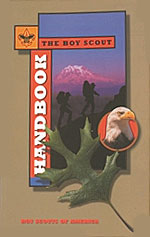
If you were stranded on a desert island, which one book would you want with you? William (Green Bar Bill) Hillcourt, who was "Mr. Boy Scout" for 50 years until his death in 1992, said the answer to that old chestnut is obvious - The Boy Scout Handbook.
Green Bar Bill had a personal interest in the answer because he was the author of the 6th, 7th, and 9th editions of the handbook. Still, can you think of a better answer?
By consulting the handbook, you could learn to read a map, choose a campsite, pitch a tent, make a ground bed, build a fire, cook a meal, and deal with common injuries. If others were marooned with you, the handbook would give you excellent advice on how to live ethically, cheerfully, and democratically with the group.
First published in 1911, the handbook has been revised and rewritten every eight to 10 years. The newest version, the 11th Edition, was published late last year with a first printing of 750,000 copies. Its $7.95 price is one of the best bargains in the book world.
Work on the 11th Edition began three years earlier. Joe C. Glasscock, director of program development in the Boy Scout Division, headed a team of top Scouting volunteers and professionals charged with overseeing the book's creation. They began by asking selected groups of Boy Scouts and Scouters what they liked - and didn't like - about the 10th Edition.
The surveys found that, in general, they liked that edition, first published in 1990, just fine - although some were bothered by its heft of more than 660 pages. Others thought the content could be organized to better reflect the advancement trail from Tenderfoot to Eagle Scout. And some advised using more photographs of real Scouts instead of professional models.
To incorporate suggestions from survey groups and other sources, the committee asked Robert C. Birkby, author of the 10th Edition, to write the new version.
An Eagle Scout and former conservation director at Philmont Scout Ranch in New Mexico, Birkby also wrote the BSA's Conservation Handbook and several outdoor merit badge pamphlets. During the 1960s he was a Scout in Troop 77 in rural Sidney, Iowa, and like many former Scouts, he looks back fondly at the handbook he used as a youth - in his case, the 6th Edition.
The cover was a Norman Rockwell painting of a smiling, backpacking Scout striding purposefully along with a copy of the handbook in one hand. (Among other things, the 6th Edition was the first to officially have a cover title of Boy Scout Handbook; previous editions were labeled Handbook for Boys.)
"Our troop did its camping in the woodlots and cornfields of western Iowa," Birkby recalled. "What the handbook did was show that you didn't have to be in the mountains or in spectacular country to camp out overnight and cook your meals and learn how to use map and compass. The handbook transformed all that into a magnificent adventure."
Birkby was also familiar with previous handbooks, because his father, who was Scoutmaster of Troop 77, had a complete collection dating back to 1910.
"Each handbook attempts to address the boys of a particular era," he told Scouting magazine when the 10th Edition (which added The to Boy Scout Handbook) was published. Earlier handbooks seemed to speak "in a very authoritarian voice," he noted, while boys today "relate better to a handbook that helps them discover things on their own."
In its attempt to better address the current generation, the 11th Edition follows trends already evident in magazines and books for young readers, featuring large, sharp, color photography and illustrations and crisp, to-the-point writing.
At 8 3/8 inches high and 5 3/8 inches wide, the new handbook uses a larger format than any previous edition, but its 472 pages are nearly 200 fewer than the bulkier 10th Edition. Text on many subjects ("Selecting a campsite," "How a compass works") often begins and ends on a single page.
"We cut down on the number of words," explained Joe Glasscock, "because 11- and 12-year-olds are more likely to read a shorter text block than something that seems to run on for pages."
The first half of the new handbook is devoted mainly to advancement requirements for Tenderfoot through First Class. Separate chapters on each rank provide information for passing every requirement or indicate where to find the necessary information in other sections of the book.
To reduce the number of pages, many of the almanac-type information segments not specifically related to advancement requirements were removed. These included topics like Morse code, semaphore signaling, sign language, state flags, canoeing, rowing and bicycling techniques, seasonal sky star charts, and most detailed information about plants and animals.
"For nature information, we now direct Scouts to a variety of reference sources," Glasscock said. "And we'll include additional information in future editions of the BSA Fieldbook."
The handbook's second half provides how-to information on Scouting skills like hiking, camping, cooking, first aid, citizenship, and personal and physical fitness.
The newest handbook continues the growing emphasis on low-impact or "leave no trace" outdoor living. The technique for building a ground fire with kindling is still explained (find enough "dead twigs ... no thicker than a pencil ... to fill your hat twice") and illustrated; but camp stoves are promoted as both practical and a good way to protect the environment. Ditching around tents for drainage - routine a generation ago - is verboten; so is digging shoulder and hip holes for ground beds.
Through nine decades of publication, the handbook has gradually reflected changing attitudes toward hiking and camping. Scouts of each succeeding generation learned less about altering the environment for camper comfort and more about visiting a natural wilderness without changing it or even leaving evidence of having been present.
The 400-page 1st Edition of the handbook, published in the summer of 1911 when the Boy Scouts of America was 18 months old, contained quite a bit of chop-down-a-tree camping advice in its 125 pages devoted to camping skills and life in the outdoors. For example, overnight campers were told to build lean-to's, using fresh-cut poles with branches of balsam or hemlock for thatching. They were then to cut more boughs to make a soft and fragrant ground bed, over which the camper would spread his poncho and blankets.
The first Handbook for Boys cost 25 cents and had numerous black-and-white photos and drawings. It contained 24 pages of advertisements, selling hiking shoes, carbide lamps for camping, a Boy Scout Union Suit (a one-piece, four-button, shoulder-to-thigh "new kind of underwear"), jackknives, bouillon cubes, shredded wheat, .22 rifles, and a variety of books and magazines (but not Boys' Life, which had just begun to publish and was not yet owned by the BSA).
 Published in 1911, the 1st Edition told how to start a fire by friction, build a log cabin, and stop a runaway horse. |
The book's many sections were written by authorities on specific subjects. In a chapter on "Woodcraft," BSA Chief Scout Ernest Thompson Seton, noted naturalist and author (see "The Rare 1910 Handbook"), explained how to make fire by friction, find one's way in the woods, estimate heights and distances, and build a log cabin. Also covered were archery, astronomy for outdoorsmen, trees, and animals.
An official of the Young Men's Christian Association, which operated 400 summer camps at the time, wrote the chapter on high-impact campcraft. Experts from the Audubon Society and various government agencies contributed sections on birds, shells and shellfish, reptiles, insects, fish, geology, and plants.
The chapter on first aid and lifesaving was written by an Army Medical Corps doctor. It told how to take action in different emergencies, including stopping a runaway horse, killing a "mad" dog, dealing with leaking illuminating gas, and holding a carpet to catch jumpers from burning buildings. First aid advice included treatment for everything from shock, fractures, and severe bleeding, to chills, sunburn, and hiccups.
Swimming was not the popular sport it is today and was presented mainly as a necessary skill for lifesaving. Scouts were shown how to break the "death grip" of a panicky rescue victim and tow a "drowning swimmer" to shore.
Modern "rescue breathing" and "cardiopulmonary resuscitation" had not yet been developed. Instead, the victim was laid facedown on the ground, and the rescuer performed "artificial respiration" by straddling his body at the hips, putting pressure on the lower ribs to force water out of the lungs, and releasing it to let air in. Proper technique was assured by performing the procedure to the rhythm of "Out goes the bad air, in comes the good."
(Editor's note: A facsimile edition of the 1911 Handbook for Boys, No. 33100, $13.50, is available from the BSA Supply Division.)
The 2nd Edition of the Handbook for Boys, published in 1914, resembled the 1st Edition in content and organization. However, World War I was erupting in Europe, so the book contained a reassuring note for parents who feared Scouting was designed mainly to train their sons to become soldiers: "The Boy Scout movement neither promotes nor discourages military training, its chief concern being the development of character and personal efficiency of teen-age boys."
  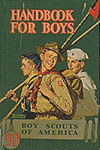 The 2nd Edition, in 1914, emphasized conservation of natural resources. In 1927, the 3rd Edition had more detailed, sophisticated first-aid instructions. The 4th Edition appeared in 1940, and Scouts began learning about ecology and the "web of life." |
Scouting's emphasis on the conservation of natural resources became evident in the 2nd Edition. William T. Hornaday, director of the Bronx Zoo in New York City, railed against indiscriminate killing of wildlife, arguing that "Not one tree should be cut down, not one bird, mammal, or fish should be killed, without a reason so good that it fully justifies the act."
During the era of the Great Depression, Scouts used the 3rd Edition, published in 1927. It was illustrated with black-and-white drawings, some in cartoon style.
First-aid instruction was becoming more detailed and sophisticated. But antibiotics had not yet been developed, and minor problems such as bruises and small cuts were treated as potentially life-threatening - which they were.
Attention to good conservation practices was redoubled in the 4th Edition, which appeared in 1940. Scouts still ditched tents, but they no longer made lean-to's for camp-outs. Under the tutelage of Ted S. Pettit, who served for many years as BSA's director of conservation, Scouts began learning the principles of ecology and the "web of life."
 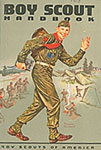 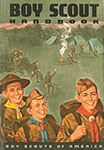 The 5th Edition, in 1948, was the last to have detailed plans for tents, pack frames, and tin crafts. The 6th Edition was used by millions of baby boomers, while the 7th Edition, in 1965, was the handbook for Scouting's peak membership years. |
The 5th Edition, published in 1948, was the first to forego bylines for writers. It was also the last to include detailed plans for making tents, pack frames, and tin crafts.
The 6th Edition, the handbook for the baby boom generation, came out in 1959. It was the last to carry ads and the first to have color drawings on inside pages. It introduced mouth-to-mouth rescue breathing to save life and aluminum foil-cooking for outdoor chefs.
Thanks to the presence of penicillin and other antibiotics for treating infections, blisters were no longer frightening. Scouts were advised to wash a blister with soap and water, puncture it with the sterilized point of a pin, and cover it with a sterile dressing.
The 7th Edition, published in 1965, was similar to its immediate predecessor and was read by boys during Scouting's peak membership years in the late 1960s.
 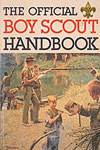  The 8th Edition introduced a new advancement program in 1972 and included more images of minority scouts. The 9th Edition, published in 1979, reemphasized Scouting's outdoor tradition. The 10th edition,. in 1990, included low-impact camping ideas and many color photographs. |
In 1972 the BSA introduced the "improved Scouting program," aimed to broaden its appeal for urban and rural boys. Its new program was supported by publication of the 8th Edition, titled simply Scout Handbook.
Gone were signaling, map-making, canoeing, rowing, tracking, lashings, and fire by friction. In their place were sections on drug abuse, family finances, child care, community problems, current events, and neighborhood conservation ideas for urban neighborhoods as well as wilderness areas.
The advancement plan was overhauled to such an extent that a Scout could reach First Class without ever going hiking or camping or cooking over an open fire.
Illustrations in the 8th Edition included many images of minority Scouts. And the next two editions maintained the long overdue diversity in its choice of illustrations. Much of their content, however, reverted to the old ways, although with some new twists.
"Boy" was put back in the title and, in the 9th Edition, Scouts were again required to hike, camp, and cook to reach First Class. The stress on inner-city Scouting was somewhat reduced, although the handbook still gave advice on city hiking and first aid for rat bites.
The jumbo 10th Edition, written by Bob Birkby, sparkled with full-color photos and drawings. Camp stoves and ideas for low-impact camping appeared for the first time, and sunscreen was recommended for outdoorsmen with fair skin.
There was even a suggestion to take an umbrella along on a hike: It fits nicely in a pack and can be used as a sunshade if it doesn't rain.
Whoever said Boy Scouts resist change?
Robert Peterson is the author of The Boy Scouts: An American Adventure.
The Rare 1910 Handbook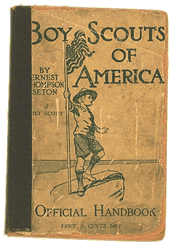 Even before the first official Handbook for Boys appeared in 1911, an instructional manual was available for Boy Scouts. It was hastily cobbled together by Ernest Thompson Seton and published in July 1910, just five months after the BSA's birth. Seton borrowed material from the Birchbark Roll, the manual for his own youth organization, the Woodcraft Indians; and from Scouting for Boys, by Robert S. S. Baden-Powell, the English founder of the worldwide Scouting movement. Despite its short life, the 1910 manual, which included information for both adult leaders and boys, actually had several different covers. The first, with the title Official Handbook, credited Seton and Baden-Powell as co-authors. Other versions showed the book's title as Official Manual. And after Seton was named Chief Scout of the BSA, a new cover listed only one author: Ernest Thompson Seton, Chief Scout. The 1910 handbook/manual had a printing of 68,000 copies, which sold for 25 cents each. According to current memorabilia price guides, collectors today are willing to pay as much as $600 for an original copy. |
It's a Best SellerSince 1911, the 11 editions of the official Boy Scout Handbook have sold more than 37 million copies. That places the handbook in third place for total sales among copyrighted books, according to Gary Ink, librarian for Publisher's Weekly, the "bible" for the book trade. The leader is The Guinness Book of World Records, with 80 million copies; and Dr. Spock's Baby and Child Care is second with 43 million. (Although often cited as the all-time, top-selling book, the Bible is not copyrighted and therefore is not included on official best seller lists. If it were, the sales of its many versions would undoubtedly put it in first place.) - R.P. |
The Boy Scout Handbook Since 1911
|
What Others Are SayingPublication of the 11th Edition of The Boy Scout Handbook generated widespread commentary in newspapers across the country. Some examples: "The book is simply unassailable; this is a guide for life." - The New York Post "The manual connects the basic tenets [of Scouting] more directly to the situations faced by boys today." - USA Today "The handbook is about building character, about making wise choices about the personal decisions that young men have to make." - The Philadelphia Inquirer "The new section [on subjects like the wise use of television and the Internet] goes perfectly with the Boy Scouts' mission of helping members set goals and prepare for life." - Fort Worth Star-Telegram |
| The Boy Scouts of America | http://www.scouting.org |